How to Effectively Use Margin in the Forex Market
Margin is the collateral you deposit with your broker in order to open up leveraged positions.
The amount of margin in your account and the amount of leverage your broker offers will determine how much your broker will lend to you and the size of positions you can open. It’s important to understand that margin is not a cost or fee, once you close your leveraged trading position, your margin is returned to you, adjusted for any profits or losses, and can be freely withdrawn.
This margin deposit just ensures you have enough capital reserved to cover your losses if your leveraged trade moves against you. As the forex market isn’t very volatile, margin trading is essentially the only way you can turn a reasonable profit, so it’s important to understand how margin works before diving into your trading journey.
Forex Margin Explained
Key margin trading terms and concepts
Let’s take a look at your MT4 trading terminal and some of the metrics related to your account and margin trading.
- Balance is how much trading capital you have deposited with your broker. When you close margin trades, your balance will be adjusted to reflect any associated profit or loss.
- Equity is a real-time reading of your account position adjusted for trades that are currently open. As the market moves in your favour or against you, your equity will fluctuate accordingly. When you have no trades open, your equity is equal to your balance. When you have trades open on the other hand, your equity is equal to your balance +/- your rolling profit or loss.
- Used margin is the amount of margin you have used to open your current positions. Generally, once this margin is utilised, it can not be used again until you close your positions. An exception to this is hedging mode where opening up a counter position in the same market essentially cancels out your first position, freeing up your used margin.
- Free margin is the amount of equity you have left available to open up new positions. It is your account equity minus used margin.
- Margin level looks at the percentage relationship between your account equity and your used margin. If your margin level is over 100%, you still have enough equity to open a new position. If however, your margin level drops below 100%, you are not able to open any new positions as you are at risk of receiving a margin call.
- Margin call is a notification you receive advising your equity has dropped substantially and your positions are at risk of being forcibly closed to prevent further losses. You can either close your positions out yourself or add further funds to your account to adequately support your positions.
Example Margin Trades
Let’s take a look at some example trades to bolster your understanding of these terms and margin trading generally.
Margin Trading Example 1 – Leaving Free Margin
Imagine we have a $5000 trading account and open a position that requires $1000 of margin as collateral. As we have $5000 of equity, after using $1000 of margin, we have $4000 of free margin left available.
If we have only used $1000 of our available margin and have $4000 of free margin left over, we are using 20% of our maximum available margin and our margin level will show as 500%.
This means we could potentially open up four more positions before our margin level would drop to 100%, but we don’t have to.
This is an example of responsible use of margin and leverage in forex trading.
Margin Trading Example 2 – Getting a Margin Call
In our next example, we’re going to look at a less responsible and much more risky trade.
In this example, we use all of our available margin right out of the gates, the trade moves against us and we receive a margin call.
Picture we have a $5000 trading account and we open a position that requires $5000 margin as collateral. Upon opening the position, our margin level is 100% and we have no free margin left to open new positions.
The markets moves against us slightly and our margin level drops below 100%, then continues to move against us, resulting in receiving a margin call. We scramble to deposit more funds to protect our position, but we are unable to finalise the deposit before the market declines further and our broker closes our position to protect us both from further losses.
The market then reverses violently in our favour – we were right about the trade, but it doesn’t matter anymore because we are no longer in the market and have already lost the majority of our account balance – not a great feeling.
Avoiding Margin Calls
In the above example we attempted to act on the margin call but were unable to do so in time.
As such, waiting till you receive a margin call to begin managing your account effectively is not a great strategy. Instead, you should always be managing your account effectively to avoid receiving a margin call in the first place.
Reducing your available leverage is a great way of avoiding margin calls.
If you’re getting margin calls all the time, then you clearly have too much leverage available to you. It’s also important to note that you don’t have to and you really shouldn’t be using all of your available leverage.
If your margin level is well above 100% it is much, much harder to receive a margin call.
It’s like a fast car, just because it can go above 200 km/h doesn’t mean you need to drive it that fast every time you drive it, and you probably shouldn’t drive it that fast ever.
With Great Power Comes Great Responsibility
When it comes to margin trading in forex, it’s like the old adage: “With great power comes great responsibility”. Leverage is an incredibly powerful tool and when used responsibly, can generate substantial profits for your account.
But if you don’t manage your account and margin requirements effectively, you’re not going to have a very long career as a forex trader.











